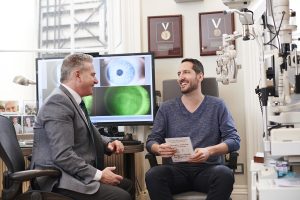Understanding the Safety and Risks of Laser Eye Surgery

Laser Eye Surgery can be a daunting prospect. Let’s face it, opting for elective surgery on one of our most valuable and important assets – our eyes – is a decision that requires a lot of thought, research, and preparation. But, the abundance of misinformation and tabloid-style scare stories spread around on the internet can make it difficult to truly understand the safety and risks of Laser Eye Surgery.
Let’s start off by stressing that Laser Eye Surgery is not the most commonly performed elective surgery in the world. Millions of people around the globe are now enjoying better vision thanks to the ongoing innovation in the field. Furthermore, in the hands of experienced and qualified surgeons, Laser Eye Surgery is also an extremely safe procedure.
Nonetheless, as with any kind of surgery, there are still some risks that every patient should be aware of.
The Safety of Laser Eye Surgery
In 2006, the National Institute for Health and Care Excellence (NICE) – the official body that produces guidance for doctors in the UK – completed a two-year in-depth study of Laser Eye Surgery. They concluded that Laser Eye Surgery “is safe and efficacious for use in appropriately selected patients.”
This conclusion is supported by an abundance of published literature on Laser Eye Surgery. On the whole, studies of the procedures have demonstrated excellent patient satisfaction, clinical outcomes, and safety.
But that isn’t to say that it is completely risk-free. Like all types of surgeries, Laser Eye Surgery carries a small risk of complications (defined as an unexpected occurrence). Luckily, in the case of Laser Eye Surgery, these occurrences are very rare and, thanks to advanced technology and surgical expertise, the vast majority of these complications can be corrected.
The chance of an expert surgeon – like our surgeons at London Vision Clinic – being faced with a problem of marked permanently reduced vision or quality of vision, that they could not correct to a satisfactory standard, is around 1 in 30,000.
How is Safety Measured?
In Laser Eye Surgery, measures of safety take into account any risk of compromise to your vision.
This includes blurring, double vision, or any other distortion that cannot be corrected by glasses to achieve the same level of visual acuity you had with glasses before the surgery (your Corrected Distance Visual Acuity, or CDVA).
In other instances, the vision may be improved but there is some blurriness. In this case, the vision is not compromised – it is simply not fully focused. This blurriness can be corrected by glasses or, as is more often the case, by a simple enhancement procedure.
The standard method of measuring the level of visual compromise is to measure the number of lines a patient is no longer able to read on an eye chart. For example, if a patient was able to read the letters up to the 20/16 line before surgery, but can only read to the 20/25 line – with glasses – after surgery, this would be considered a loss of two lines of CDVA.
According to NICE’s 2006 study, which assessed the results of various published studies, on average, less than 1% of LASIK patients lost more than two lines of CDVA after Laser Eye Surgery.
However, it is important to remember that these figures are almost 20 years old. With the use of the latest techniques (such as SMILE) and expertise, this risk becomes even smaller. London Vision Clinic was the first Laser Eye Surgery clinic in the UK to introduce the latest innovation in the procedure – SMILE. Today, the risk of an eye losing two lines of best-corrected vision is around 1 in 1,000.
The Risk for Higher Prescriptions
While the level of risk is very low for all patients, the chance of complications does vary depending on your prescription. The risks for your particular case will be explained thoroughly to you by your consultant at your screening appointment.
The best way to ensure the greatest safety levels when undergoing Laser Eye Surgery is to select an expert surgeon. Experienced and knowledgeable surgeons, with the help of the best technology, a thorough screening process and regular follow-up appointments, give you the best possible chance of achieving optimum vision quality.
Common Side Effects
Laser Eye Surgery is now a minimally invasive procedure that can be completed in minutes. But reshaping the eye will always prompt an inflammatory response from the body.
Most of the side effects associated with Laser Eye Surgery are down to this inflammatory response. For example, patients will usually experience some degree of dry eyes, swelling, and the occurrence of night glare such as halos and starbursts.
The good news is that these side effects are usually mild and can be managed with the help of your personal aftercare regime and eye drops. Swelling and the resulting vision disturbances typically resolve themselves within a matter of weeks or months.
If you are interested in the potential of Laser Eye Surgery but would like to learn more about the risks associated with treatment, get in touch with one of our friendly clinic coordinators, or Book a Consultation, today


